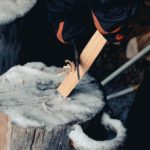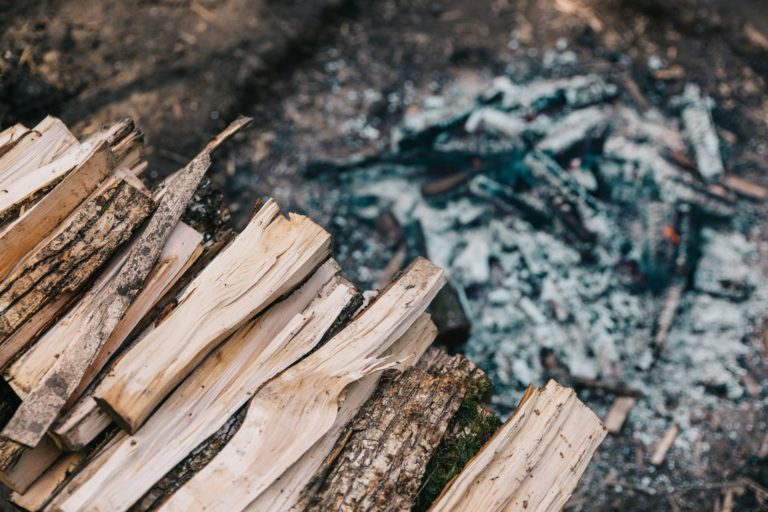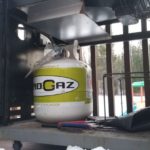MAKE YOUR CAMPFIRE LAST
Whether you’re backpacking in the deep woods or spending the weekend at the local campground, one of the most important and enjoyable parts to any successful camping trip is a solid campfire. A warm, glowing campfire can bring friends and strangers together to converse and laugh through the night, create lasting memories of roasting marshmallows and making s’mores for the kids, or be the essential means of cooking and warmth for a wilderness adventure.
No matter which style of camping trip you’ll be taking, selecting the best campfire wood to burn will be essential to starting and keeping any good fire going.
Starting a fire can both be frustrating and time consuming without the right tools and knowledge at hand. But with the right materials, you’ll look like the king of the campground and will have the neighboring campsites envious of your roaring flames.
Any good fire will start with the essential starting kit: dry tinder materials, kindling wood and a fire starter.
TINDER
Tinder is material that is easily combustible and is used as the first material in starting a fire. Tinder is a finely divided, open material which will begin to glow under a shower of sparks. The flaming tinder is used to ignite the kindling, which in turn is used to ignite the bulk material in order to produce a lasting fire. The items below are typical, easily found tinder materials:
- Newspaper (crumpled up)
- Small wood shavings (this could be from chopping wood very thinly or from sawdust)
- Dry wood barks such as Birch Bark
Wood shavings are often a natural result of splitting wood with an axe. Pick out the small pieces and use as tinder. You can also use a knife to create wood shavings from a larger stick of wood. If you happen to have a woodworking shop at home, packing shavings or sawdust into a small bag and using it as tinder is also very effective.
Paper barks such as birch bark are also very effective in acting as tinder materials. If picking birch bark off of live trees, it is important to only select the bark that is already curling along the tree and remember to always leave a layer of live bark along the tree. Peeling the bark right down to the wood will effectively kill the tree which is not the intent of any well intentioned camper among the beauty of the forest.
Using the material you’ve found, make a small pile in the middle of the fire pit. You are now ready for the kindling.


KINDLING
Once the tinder material is in place, the next step to building that perfect campfire is to place the kindling wood on top in a crisscrossed fashion. Kindling wood should again be very dry so that it can catch a flame quickly and burn hot. The size of kindling wood will generally be between 1/8th of an inch and 2 inches in diameter with varying lengths. Having different sizes in place will help promote airflow and get the fire started quickly.
When selecting kindling woods, the most common types used are pines and cedars which are from the softwood family of trees. These types of wood will burn hot and fast which is great for getting the fire going, but they will crackle and smoke significantly so typically are not used as the main firewood source.
If you’re searching for kindling in the forest, look for fallen branches on the forest floor or for dead branches that look dry and light. Break the branches into lengths of approximately 12 inches and pile crisscrossed on top of your tinder material. Once the tinder material is lit from below with a flame, both the tinder and kindling will light up nicely.

STARTER FLAME
In order to get any fire going, you will first need a starter flame. A lighter or matches will work great and are the most common items used as fire starters. Rubbing sticks together will also work if you have impeccable patience and time on your hands.
If you’re looking for something different, a permanent matchstick also works great, with a few bonuses added. Keychain flint fire starters are small and have a waterproof seal to ensure that they stay dry and usable when you need them. They are also durable and once lit, the flame holds strong and can withstand a large amount of wind pressure. Using this type of fire starter can be tricky, especially if you’ve never used one before. Make sure to read the instructions and get comfortable using it before heading out on your camping trip.
FIREWOOD
Firewood will be the main ingredient to keeping a warm, glowing flame going until you’re ready to pack it in for the night. For the bulk material, you will mainly want seasoned hardwoods which will burn warm and slow, leaving large hot coals as they burn down.
Typical hardwoods that can be used are oak, maple, ash and birch. Having said that, there are many species of trees which can be used for firewood. Utah State University has created this great table of firewood facts. Again, it is important that the wood is seasoned; usually requiring that it has been drying for about one year. When wood is seasoned it will have a moisture content between 15-20% which will allow it to burn efficiently and with little smoke.
If searching the forest for firewood, look for fallen trees of the hardwood family. If the wood is seasoned enough for efficient burning, the wood will look grey and cracked which occurs as the log dries out. A chainsaw or axe will be needed to cut bigger logs into blocks between 12 and 16 inches in length. Blocks in excess of approximately 6 inches in diameter will burn more efficiently if they have been split first with an axe.
FINDING CAMPFIRE WOOD
Always check local rules and regulations with respect to collecting deadfall wood for campfire purposes prior to your camping trip. This will ensure you don’t run into any issues which could ruin an otherwise fun-filled vacation.
Of course, if you are planning to camp at a local campground there will be many options for purchasing kindling and firewood. Campgrounds will often sell bundles of each which will already be seasoned and ready for your bonfire. Often, local residents will also be selling campfire wood along the side of the road, which in many cases can be the cheaper option. Take a little drive around, look at the neighborhood and meet some locals while also supporting their local economy.
No matter where you’re camping or who you’re with, a good bonfire will ensure that you have a great time filled with the memories made around that glowing ball of flames.

If you should purchase from an affiliate link provided in this post, I may receive a small commission.




